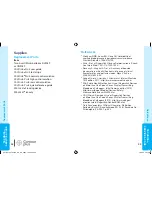
48
TECHNICAL,
SER
VICE & CARE
49
TECHNICAL,
SER
VICE & CARE
CAUTION:
Do not allow cleaning solution to run in or around
the buttons, battery cover or test strip port. Doing
so may cause a malfunction.
WARNING
If you are experiencing any of these symptoms,
test your blood glucose. If your test result
is under 2,8 mmol/L or above 13,9 mmol/L,
contact your health care professional
immediately.
For additional information and a complete
list of symptoms, contact your health care
professional.
WARNING
Health care professionals or persons using this
system on multiple patients should follow the
infection control procedure approved by their
facility. All products or objects which come in
contact with human blood, even after cleaning,
should be handled as if capable of transmitting
infectious diseases. The user should follow the
recommendations for prevention of blood-borne
transmissible diseases in health care settings
as recommended for potentially infectious
human specimens.
Symptoms of High or Low Blood Glucose
Caring for Y
our Meter
Caring for Your Meter
• Store meter in the carrying case provided whenever
possible.
•
Wash and dry hands well before handling to keep
the meter and test strips free of water, oils and
other contaminants.
• Handle the meter carefully to avoid damaging the
electronics or causing other malfunctions.
• Avoid exposing meter and test strips to excessive
humidity, heat, cold, dust, or dirt.
Cleaning Your Meter
The exterior of the C
ONTOUR
®
P
LUS
meter can be
cleaned using a moist (not wet) lint-free tissue with a
mild detergent or disinfectant solution, such as 1 part
bleach mixed with 9 parts water. Wipe dry with lint-free
tissue after cleaning.
Symptoms of High or Low
Blood Glucose
You can better understand your test results by being
aware of the symptoms of high or low blood glucose.
Some of the most common symptoms are:
Low blood glucose
(Hypoglycaemia):
• shakiness
• sweating
• fast heartbeat
• blurred vision
• confusion
• passing out
• irritability
• seizure
• extreme hunger
• dizziness
High blood glucose
(Hyperglycaemia):
• frequent urination
• excessive thirst
• blurred vision
• increased fatigue
• hunger
Ketones (Ketoacidosis):
• shortness of breath
• nausea or vomiting
• very dry mouth
84721973_CntrPLUS_UG_EN_FpBp_v2.indd 48-49
84721973_CntrPLUS_UG_EN_FpBp_v2.indd 48-49
1/22/13 9:41 AM
1/22/13 9:41 AM




























